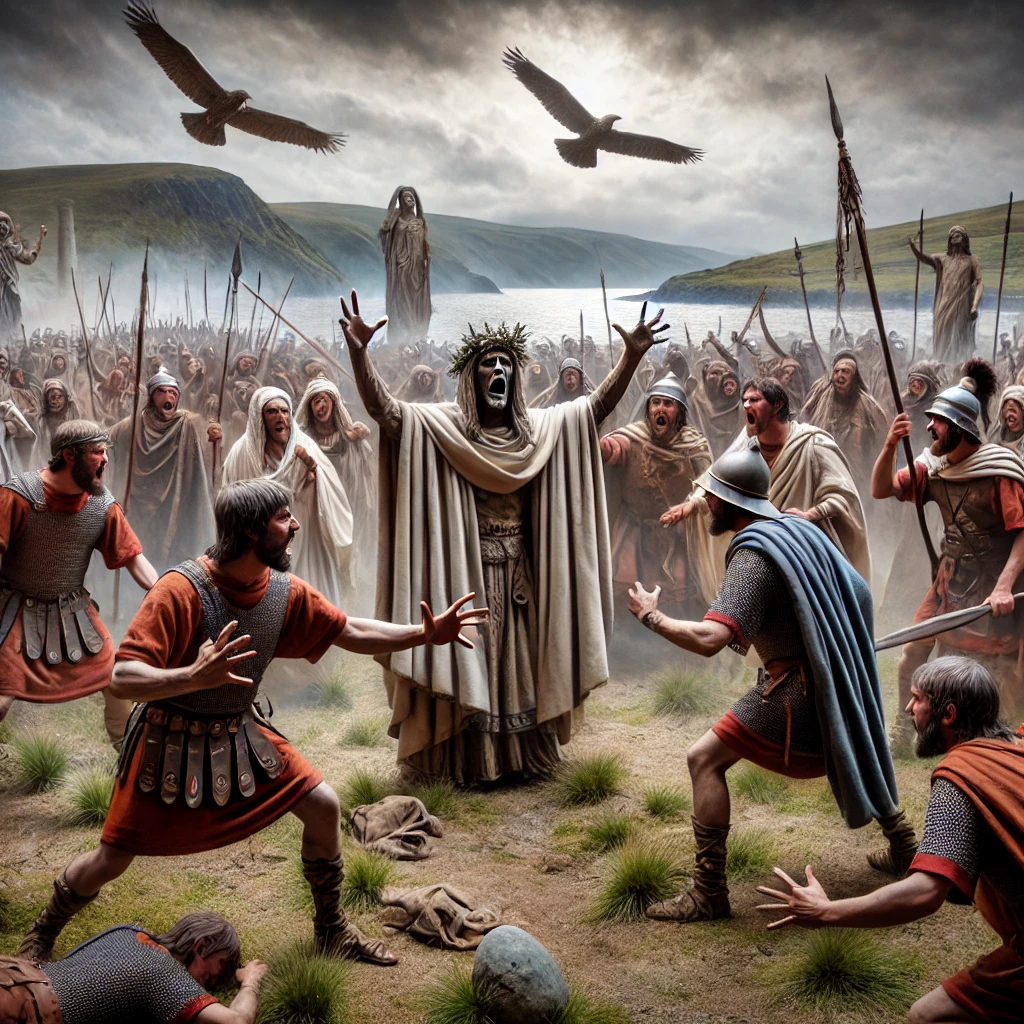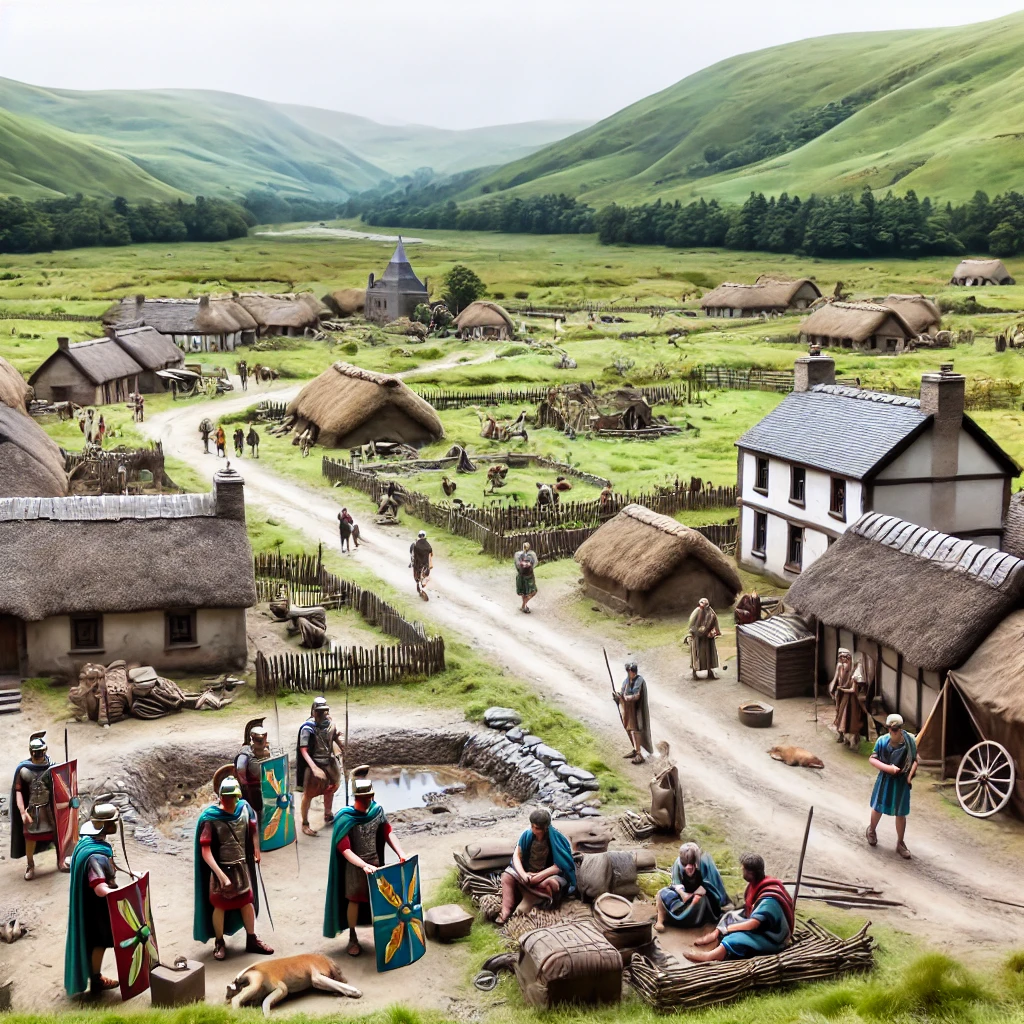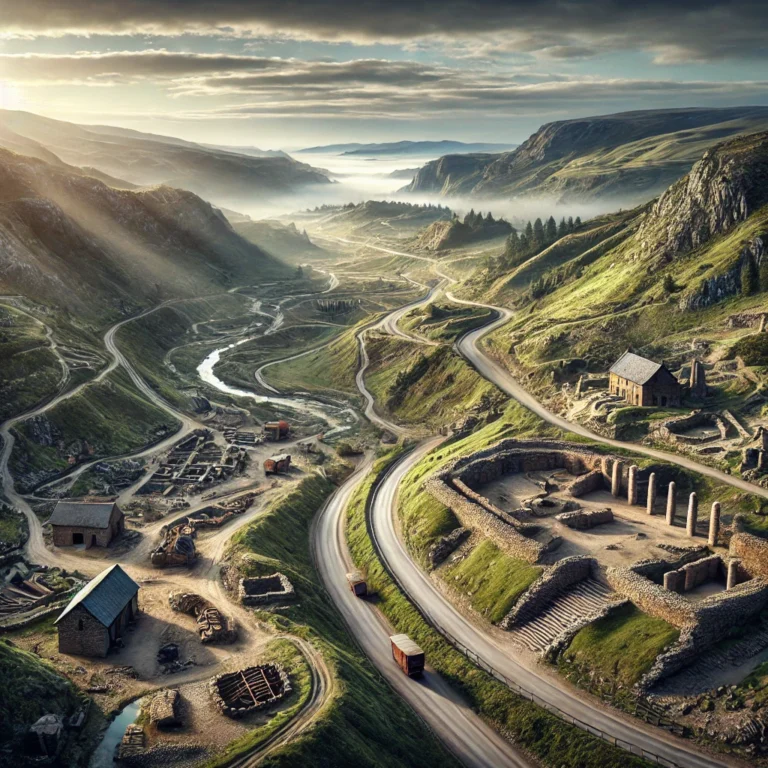There’s so much cultural legacy left behind. I live near a famous Roman road and even lived on an estate called Roman way. Have you ever wondered Why did the Romans invade Wales?
The Roman Empire, known for its vast conquests, saw in Wales a land of untapped potential. But what drove them to risk battles in this rugged, mountainous region? What strategic or economic significance did the old kingdom of Wales hold for the Empire? In this post, we’ll explore why did the romans invade Wales? The battles they fought, and the systems they built to rule, delving into the lasting impact of their presence in Welsh history.
Why Did the Romans Invade Wales? Appeal Of the Land
The Romans were not simply conquerors but skilled resource managers, recognising the vast potential of territories rich in minerals like gold and copper. Wales, with its wealth in metals, was a natural target for exploitation by an empire hungry for resources.”
– Professor David Mattingly, Roman Britain Historian
The Roman Empire wasn’t just driven by the desire for territory; it was fuelled by a hunger for resources, control, and dominance over Europe. Wales, though challenging in terrain, offered them substantial incentives.
Rich Resources
Pre Roman Wales was rich in natural resources, particularly minerals like gold, copper, and lead. The Romans, adept at engineering and mining, recognised the value these resources could add to their empire. The gold mines at Dolaucothi, for example, became one of the primary sites of extraction. The precious metals from Welsh soil flowed into Rome, bolstering the Empire’s wealth and powering its economy.
Why Did the romans Invade Wales? Strategic Military Position
Beyond resources, the geographical position of Wales held significant strategic value. Its coastline provided security for the western borders of Roman Britain. By conquering Wales, the Romans ensured control over the entire island, making it easier to defend against potential invasions or rebellious uprisings. Wales became a buffer zone, guarding against threats from the Irish Sea. Why did the Romans Invade Wales? The same reason why most other invasions occur – resources and strategic positioning.
The Roman Military Campaign in Wales

The Romans, known for their powerful military tactics, did not face an easy conquest in Wales. Fierce resistance from the local tribes, who knew their terrain well, made the invasion challenging and protracted.
Roman Military Strategy in Wales
The Romans faced a unique challenge in conquering the Welsh tribes, given the region’s rugged terrain and the fierce, guerrilla-style resistance of the locals. To counter this, Roman forces adapted their military strategy, using tactical formations and fortified camps to withstand sudden attacks. They employed the testudo formation, allowing their soldiers to shield themselves from missiles and projectiles during sieges. Over time, Roman generals became adept at navigating the Welsh landscapes, setting up forts in strategic locations to maintain a steady supply line and secure control over the tribes.
Roman Strategy and Warfare
Roman military strategy was unmatched, with organised formations, fortified camps, and disciplined soldiers. The legions advancing into Wales followed a systematic approach. They built temporary forts as they progressed, creating supply lines and securing conquered areas. The Romans utilised “divide and conquer” tactics, aiming to weaken tribal alliances and isolate the more resistant factions.
Key Battles and Welsh Resistance
Archaeological evidence from forts like Caerleon suggests that the Roman military used advanced techniques for fortification and logistics, supporting long campaigns in hostile territories like Wales (Source: Journal of Roman Archaeology, 2019).
The invasion was marked by a series of key battles against tribes such as the Silures and Ordovices, known for their fierce resistance. The legendary chieftain Caradog, or Caractacus, became an emblem of Welsh defiance. He led guerrilla-style ambushes and used the Welsh terrain to his advantage. Caradog’s resistance became so notorious that, even after his capture and transport to Rome, he was granted a public hearing before Emperor Claudius, who admired his bravery.
The Conquest of Anglesey
Known as Ynys Môn in Welsh, the island of Anglesey was the spiritual heart of Wales, a sanctuary for the revered Druids. To the Romans, the Druids were not just spiritual leaders—they were the symbolic and practical backbone of Welsh resistance.
Anglesey: The Heart of Druidic Practice
“The Druids were not just religious figures but the very heart of Celtic resistance. To the Romans, subduing the Druids meant breaking the spirit of the Welsh tribes.”
– Miranda Aldhouse-Green, Druidic Scholar and Author of The Gods of the Celts
The Druids were influential figures in Welsh society, responsible for religious practices, justice, and knowledge. They wielded power over the tribes, advising chieftains and invoking the spirits of ancestors. Anglesey, as their sacred island, became a focal point of Welsh unity and defiance, which the Romans could not ignore.
The Brutal Assault on Anglesey

In 60 AD, Suetonius Paulinus led a Roman assault on Anglesey with the goal of eradicating Druidic influence. Accounts describe a haunting scene: Druids chanting as they confronted the legions, women raising torches, and defenders fighting with unmatched zeal. The Romans destroyed sacred groves and slaughtered Druids, aiming to dismantle Welsh spirituality and weaken the backbone of resistance. The fall of Anglesey was a turning point, stripping the Welsh tribes of a vital symbol of unity.
Roman Infrastructure and Control in Wales
Studies of Roman roads in Wales show that these routes were not only military but also economic, facilitating trade and the integration of remote areas into the Roman economy (Source: Britannia, Journal of the Roman Society, 2021).
Once the Romans had established control, they began constructing a network of infrastructure that would secure their rule and bring Wales into the fold of Roman Britain.
Roads and Trade Routes
Roman engineers built extensive roads through Wales, linking forts and facilitating movement. These roads weren’t merely military routes—they became trade arteries, bringing goods from the continent and enabling economic integration with the rest of Roman Britain. Roads like the Sarn Helen allowed soldiers and traders to move swiftly, while also serving as a constant reminder of Roman power.
Fortifications and Settlements
Fortified settlements sprang up at key locations, such as Segontium near Caernarfon, where Roman soldiers were stationed to guard against revolts. These forts doubled as administrative centres, where taxes were collected, and local governance was overseen by Roman officials. Around these forts, small communities developed, and the influence of Roman culture began to permeate the local society.
Welsh Resistance Leaders and Heroes
Welsh resistance against the Romans produced a lineage of legendary leaders who have become icons of Welsh resilience. Figures like Caradog (Caractacus) are celebrated for their courage and tactical acumen in challenging the might of Rome. Leading his people through guerrilla warfare and surprise attacks, Caradog’s defiance symbolised the indomitable spirit of Wales. Other local leaders inspired similar resistance, with stories passed down through generations, reminding the Welsh of their ancestors’ bravery and their enduring connection to the land.
Life Under Roman Rule

Roman rule introduced structured economic systems to Britain, but it also imposed heavy taxes and often exploited local resources, sometimes at the expense of indigenous communities.”
– Dr. Peter Salway, Historian and Author of A History of Roman Britain
As the Romans settled in, Welsh society underwent significant changes. Roman rule impacted daily life, from economic practices to cultural influences, as the conquerors introduced new systems and values.
Life of the Welsh People Under Roman Rule
Roman occupation brought significant changes to the lives of the Welsh people. While some embraced the new infrastructure, including roads and trade networks, others resisted the cultural shifts. The Romans introduced new laws, leading to a mixture of Roman and tribal legal practices. While Roman rule brought access to new goods and trade opportunities, it also imposed taxes and conscription into the Roman military. This duality shaped the Welsh experience, with some seeing the benefits of Roman civilisation, while others fought to retain their traditional ways.
Economic Shifts and Labour
Roman rule brought an organised economic structure, with taxes and regulated trade. The Welsh people, particularly in areas near Roman forts, were introduced to new agricultural techniques and crafts. Some were employed in the Roman mining industry, particularly in extracting valuable metals like gold and lead, which were sent back to Rome. While the economy expanded in some ways, it was also exploited for the Empire’s benefit, often leaving local resources depleted and labourers strained.
Cultural Influence and Romanisation
The Romans brought their language, customs, and architecture to Wales. Latin became the administrative language, and Roman culture influenced everything from clothing to religious practices. In certain areas, the locals adopted Roman styles of dress, coinage, and even domestic architecture, building houses with Roman-style features such as tiled roofs and heating systems. While some aspects of Roman culture were embraced, Welsh identity remained strong, with local customs and the Welsh language continuing alongside Roman influence.
The Decline of Roman Power
By the early 5th century AD, the Roman Empire was crumbling. Political instability and economic strain left distant provinces like Wales vulnerable as Roman resources were redirected back to protect the heart of the Empire.
The Decline of Roman Influence in Wales
As the Roman Empire weakened under the pressures of internal strife and external invasions, their control over distant provinces like Wales began to wane. By the early 5th century, Rome could no longer maintain its authority over Britain, leaving the Welsh tribes to reclaim their autonomy. The Roman withdrawal marked the end of an era but left behind a complex legacy. Without Roman oversight, the Welsh began to re-establish their tribal systems, blending the remnants of Roman influence with their own traditions to rebuild a uniquely Welsh society.
Withdrawal of Roman Legions
In 410 AD, Emperor Honorius famously instructed Roman Britain to “look to its own defences,” signalling the withdrawal of Roman legions from the British Isles. The departure left Wales without the military support that had enforced Roman rule. While some Romanised communities tried to continue the Roman way of life, many areas reverted to traditional Welsh practices, and local chieftains reclaimed authority.
Impact of the Roman Departure
The Roman withdrawal left a lasting legacy on Welsh society. Roman roads, forts, and towns remained, some of which were integrated into Welsh settlements. The skills and knowledge imparted by the Romans, such as advanced building techniques, influenced Welsh craftsmanship for generations. Yet, without the Roman military to provide stability, Wales faced new threats from neighbouring Anglo-Saxon tribes, setting the stage for future conflicts and shaping the next era of Welsh history.
Legacy of Roman Rule in Wales

Although Roman rule eventually ended, its impact on Wales was profound and enduring. Roman engineering, administrative practices, and cultural exchanges left traces that would shape Welsh society for centuries.
Enduring Influence on Welsh Infrastructure
The Romans left behind roads, fortifications, and towns, which became the foundation for medieval Welsh settlements. Roads like Sarn Helen (I literally live half a mile away from a section of this road) remained critical for trade and travel, linking communities across Wales. These infrastructure developments helped bind the region, promoting communication and trade in a way that hadn’t existed before the Roman occupation.
Cultural Blending and Resistance
Roman rule introduced Latin and new cultural practices, but the Welsh retained a strong sense of identity. (my grandad spoke Latin). The influence of Roman customs can be seen in some Welsh legends and language, yet the resilience of the Welsh people ensured that their heritage endured. The legacy of resistance—embodied by figures like Caradog and the Druids of Anglesey—continues to resonate, symbolising Welsh resilience and pride.
Key Takeaways: Why Did the Romans Invade Wales?
- Strategic Conquest: the answer to why the Romans invaded Wales lies in it’s resources and strategic military positioning.
- Fierce Resistance: Welsh tribes, led by figures like Caradog and the Druids of Anglesey, resisted Roman rule, showcasing their fierce independence.
- Lasting Infrastructure: Roman roads, forts, and mining operations transformed the Welsh landscape and economy, leaving an enduring legacy.
- Cultural Impact: Roman rule introduced new customs, language, and architecture, yet Welsh identity remained resilient and distinct.
- Enduring Legacy: Despite Roman departure, the influence of their infrastructure and cultural exchange can still be seen in Wales today.
Conclusion: The Complex Legacy of Roman Rule in Wales
The Roman invasion and occupation of Wales were pivotal moments in the region’s history. Why did the Romans Invade Wales? The motivations for the invasion—economic exploitation, strategic control, and military expansion—left a complex legacy. Wales became part of the vast Roman Empire, yet it was a land that fiercely resisted and held onto its unique identity.
The roads, forts, and cultural exchanges introduced by the Romans left indelible marks on Welsh society. However, the spirit of Welsh independence remained unbroken, and the end of Roman rule saw a resurgence of Welsh traditions and governance. The legacy of Roman rule in Wales serves as a testament to the resilience of its people and the adaptability of Welsh culture, which absorbed outside influences while preserving its distinct character.
Matt






